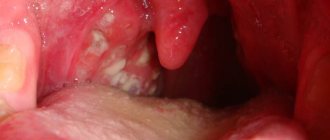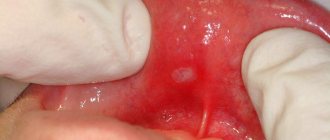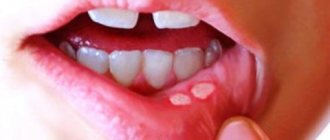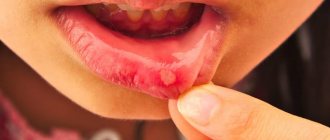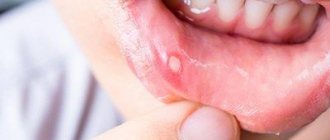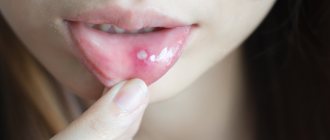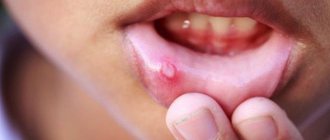- The causative agent of the disease
- Possible reasons
- What symptoms accompany the pathology?
- Features of formations
- Forms of the disease
- Severity
- Classification by clinical manifestation
- Diagnostics
- Treatment of aphthous stomatitis
- Dentists' recommendations
Aphthous stomatitis is one of the types of stomatitis, characterized by the formation of painful ulcers (aphthous) on the oral mucosa. The peculiarity of the disease is its dependence on the immune system. According to the observations of specialists, when the immune system is weakened, an exacerbation of aphthous stomatitis occurs, which predominantly has a chronic form. After therapy, stable remission is observed. To completely eliminate aphthous stomatitis in children, treatment should be carried out comprehensively and under the supervision of a specialist.
The causative agent of the disease
Aphthous stomatitis is an infectious disease that develops after penetration of a pathogen into the body. The mucous membrane protects the tissues of the oral cavity from pathogenic microorganisms, but if damaged, the infection can penetrate inside. The causative agent of aphthous stomatitis does not immediately become active. If the patient has a strong immune system, then the incubation period begins. But when the immune system is weakened under the influence of any factors, the disease begins to progress.
There are several ways of contracting aphthous stomatitis.
- Contact and household. The infection enters the oral cavity from dirty hands, objects, products, etc.
- Interior. Every person’s body contains not only “good” bacteria, but also “bad” bacteria. When the immune system is weakened, pathogenic microorganisms begin to manifest themselves. These bacteria also include the causative agent of stomatitis.
- Pathological. The cause of the disease may be another disease of a bacterial or viral nature. Stomatitis is mainly observed against the background of measles, smallpox and herpes.
Most people suffer from stomatitis in childhood, which has a simple explanation - the immunity of children is much weaker than that of an adult. Even with the chronic form of the disease, as the child grows older, relapses occur less and less frequently.
Stomatitis: symptoms and first signs
The first sign of stomatitis, including the herpetic form, is discomfort in the oral cavity, which is accompanied by burning, itching, swelling of the mucous membrane and its bleeding. Further, characteristic ulcers are added to everything, which can cover both limited areas of mucous tissue and the entire mouth. As for the generalized form of the disease, it involves the appearance of symptoms such as a sharp increase in body temperature, weakness, and difficulty eating.
READ ALSO: main signs of stomatitis in children
The presence of aphthous stomatitis is judged by the following specific signs:
- the appearance of severe dryness in the oral cavity, noticeable redness of the mucous membrane (we recommend reading: why redness of the oral mucosa may occur?),
- swelling of the tongue and its obvious redness,
- bad breath (we recommend reading: what to do if an adult has bad breath?),
- the appearance of frequent aphthous ulcers in the oral cavity in different areas,
- swelling and aphthae on the gums requiring treatment.
A person who is faced with aphthous stomatitis loses his appetite because food seems tasteless. Moreover, with the appearance of swelling and ulcers in the mouth, eating is often accompanied by severe and unpleasant pain (we recommend reading: mouth ulcers appear: causes and methods of treatment). READ IN DETAIL: what to do if white ulcers appear in the mouth in an adult?
If aphthous stomatitis is not treated immediately after the first symptoms appear, the inflammatory process will worsen. Often, aphthous ulcers appear on the corners of the lips, on the inside of the cheeks, the palate and tonsils. To prevent the disease from spreading, you must urgently consult a doctor. The sooner treatment of aphthous stomatitis begins with concomitant cure of aphthae, the sooner recovery will occur.
Possible reasons
The development of aphthous stomatitis occurs with a decrease in immunity, but not all children suffer from it. The activity of pathogenic microorganisms can occur in a child against the background of constant stress, climate change and hereditary predisposition.
Aphthous stomatitis in children is also provoked by diseases such as:
- avitaminosis;
- stomach ulcer;
- viral hepatitis;
- allergy;
- herpes virus;
- acute respiratory diseases;
- tuberculosis;
- blood diseases;
- advanced caries.
- Infection with a pathogen can occur in the following ways:
- when eating vegetables or fruits that have not been washed beforehand;
- in case of involuntary damage to the oral mucosa;
- with mechanical trauma (wounds) of the oral mucosa;
- for burns of the mucous membrane by hot food or drink;
- through dirty objects or hands.
In most cases, with “strong” immunity, infection can occur, but the infection remains in “dormant mode”, or the body’s immune system destroys it. If the influence is exerted by a provoking factor, the pathogen begins to multiply, affecting a large area of the oral cavity.
Types and symptoms of the disease
Before treating stomatitis at home, it is necessary to determine the causes and type of disease. Its infectious, viral, bacterial forms differ according to the types of treatment. A doctor can prescribe medications that will help get rid of inflammation based on identifying symptoms, test results or a smear. More than 90% of cases of stomatitis in adults are successfully cured by following the recommendations of a specialist at home. The classification presented below with detailed photos will help you understand the types of stomatitis and visually identify them.
Catarrhal
The most common type of “adult” stomatitis. Formed when the rules of oral care are violated. Mild discomfort, a slight burning sensation, pink spots on the tongue or the inner surface of the cheeks are signs of catarrhal stomatitis. Treatment in adults often does not require the use of serious medications and is carried out at home.
Ulcerative
In some cases, it is a consequence of the lack of treatment in adults for the catarrhal form of stomatitis and the connection of a bacterial infection. Most manifestations are associated with an imbalance of the natural. It is characterized by the formation of wounds with a red border, causing burning and itching. The ulcers penetrate deep into the mucous epithelium, so the treatment procedure in adults is lengthy, including antibiotic therapy. Seeing this type of disease at home is problematic due to the specific nature of its spread on the back surface of the palate closer to the tonsils.
Aphthous
In adults, it manifests itself by the formation of small round wounds - aphthae, which have a white or yellowish tint with a red edging. Sometimes it occurs with mechanical damage to the front part of the oral cavity: on the lips, cheeks, tip of the tongue. Most doctors are inclined to believe that the etymology of aphthous stomatitis is viral, citing adenoviruses and herpetic infection as the causes.
The chronic course of the disease in adults with frequent relapses indicates the presence of gastrointestinal or liver diseases. Manifested by the following symptoms: multiple lesions of the lips, cheeks, tongue; painful sensations that interfere with eating; increase in body temperature to 38. Treatment of stomatitis at home includes a set of measures related to symptomatic signs and strengthening the immune system.
- Peeling skin on the palms of the hands
- What pills to take to get rid of headaches
- Frequent urination in men
Candida
Candidal stomatitis is contagious: it is transmitted through contact in everyday life, sexually. The cause of infection is the Candida fungus. It is distinguished by a cheesy whitish coating on the tongue, cheeks, and palate. Independent attempts to remove fungal growths mechanically at home can lead to injury to the epithelium of the oral cavity and the formation of ulcers. Candidal stomatitis in adults is accompanied by a burning sensation and severe itching. For the acute form, a specific symptom is partial atrophy of taste buds.
Herpetic
The nature of this form of stomatitis is viral. A herpetic infection in the blood is a lifelong “sentence”: once it enters the body, it remains with you forever. Weakening of the immune system, stress, and nervous experiences become the trigger for the manifestation of the virus. Herpes successfully attacks the lips, corners of the mouth, the inner surface of the cheeks, and gums, forming single vesicles or colonies of bubbles with liquid. In adults, treatment of stomatitis includes the use of special medications that relieve symptoms and heal wounds.
Traumatic
Scratches, damage to the soft tissues of the mucous membrane from dentures or uneven tooth edges, burns from eating excessively hot food or drinks, chemical damage are the main causes of traumatic stomatitis. Home treatment for adults involves the use of pain-relieving ointments and gels; rinsing with herbal decoctions and... periodic lamentations: “Oh, how painful it was, I bit my lip/drank hot tea (underline as appropriate).”
What symptoms accompany the pathology?
In children, aphthous stomatitis develops gradually. At the initial stage, when the infection spreads through the mucous membrane, the child may not have any signs of damage.
The main symptom of aphthous stomatitis is the formation of erosions on the oral mucosa, which are called aphthae. They are formed as a result of damage to the mucosa. At the site of injury, aphthae are formed, having the shape of a circle or oval. After 6–14 hours, aphthae transform into erosions with a fibrous white-gray coating.
The disease may be aggravated by other symptoms:
- severe weakness;
- fast fatiguability;
- refusal to eat;
- temperature rise above 38°C;
- swelling of the mucous membrane;
- change in taste sensations;
- redness of the mucous membrane;
- enlarged lymph nodes in the neck.
Childhood aphthous stomatitis progresses much faster. After the first aphthae appear, within 24 hours a large number of erosions can form throughout the entire oral cavity. And on days 2–3, the child’s general well-being worsens.
Folk remedies
Folk remedies are usually used during follow-up treatment, when acute manifestations are eliminated.
For the treatment of stomatitis the following is used:
- infusion of chamomile flowers;
- paste from ground burdock seeds with salt and butter;
- decoction of oak bark;
- aloe juice;
- a decoction of the rhizome of snakeweed;
- yarrow decoction;
- infusion of ground rhizome of bergenia;
- infusion of pomegranate peel.
Physiotherapeutic agents include treatment of lesions with ultraviolet rays.
Features of formations
The infection affects not only the mucous membrane, but also soft tissues, as well as blood vessels that enlarge and dilate. The result is edema and hypothermia.
Aphthae have characteristic signs:
- clear edges;
- round or oval shape;
- size 3–5 mm;
- yellow, white or gray;
- red edges;
- plurality;
- large distribution area;
- elevation above the surface;
- severe pain.
Aphthous stomatitis occurs in three stages.
- Premonitory. The initial stage, in which the mucous membrane is inflamed, but dry. The child may feel discomfort and pain. The temperature rises. The general condition is deteriorating.
- Rashes. The second stage, at which the child already has rashes. To the deterioration of the general condition, refusal to eat due to pain when eating is added.
- Fading. The disease resolves on its own after 10–14 days, but becomes chronic.
With therapy, complete recovery occurs no earlier than after 7 days. The symptoms are gradually eliminated, and the mucous membrane is covered with a new healthy layer.
Forms of the disease
Aphthous stomatitis can occur in two forms: chronic and acute. Each form of pathology has its own characteristics of symptoms, which help establish the clinical picture during diagnosis.
Acute form of aphthous stomatitis
The pathological condition is accompanied by puffiness and swelling of the mucous membrane, on which aphthae of gray or white color and round shape are formed. With timely initiation of treatment, acute stomatitis lasts up to 10 days. After therapy, the mucous membrane is completely restored.
Chronic form of aphthous stomatitis
It develops in the absence of treatment for acute stomatitis, hereditary predisposition or the presence of chronic diseases that affect the immune system. The peculiarity of the pathology is the occurrence of periodic relapses. The duration of the disease is up to 14–30 days.
Severity
Chronic aphthous stomatitis can occur in varying degrees of severity. Depending on the state of the immune system and the presence of aggravating factors, the pathology progresses to a mild, moderate or severe degree. As a rule, severe pathology leads to complications.
Features of the degree of damage.
- Easy. Only one or two aphthae appear in the child’s mouth, the size of which is from 1 to 10 mm. All symptoms are mild. The disease appears no more than once a year.
- Average. Up to five afts form on the oral mucosa. Size - formations up to 15 mm. Treatment lasts about 2–3 weeks. The child feels sore and may refuse to eat. Stomatitis can occur 1–2 times a year.
- Heavy. The symptoms are pronounced. Many afts form on the mucous membrane. The disease is accompanied by systemic symptoms. The pathology practically does not disappear, since treatment lasts about a month, and the disease can appear every 1.5–2 months.
In severe chronic forms of aphthous stomatitis, it is impossible to do without treatment. Only treatment by a qualified specialist, with an integrated approach, can save a child from the disease.
Afty Setton
Setton's aphthae or necrotizing periadenitis is manifested by deep, recurrent, scarring, deforming and creeping aphthae. More common in women. At the beginning, a deep ulcer forms; sometimes this form develops after the fibrinous one.
A characteristic feature is constant manifestation. There is practically no period when there is not a single aphtha on the mucous membrane.
The precursors are the same as for Mikulicz's aphthae: temperature 37–37.5, lymphadenopathy, swelling of the tongue and mucous membranes, their slight numbness. The course of the disease is very long and undulating. Due to the fact that after healing of ulcers, deforming scars are formed, the mucous membrane becomes heterogeneous.
Photo: Aftoz Settona
With this form of stomatitis, there are always from 2 to 10 aphthae in the mouth. Some are already in the healing stage, while others are just growing. Their sizes are very significant: from 1 cm or more. The illness can last 1–2 months.
Classification by clinical manifestation
Depending on the manifestation and characteristics of the development of aphthae, the disease is classified into several forms.
- Fibrinous. Aphthae are formed after fibrous damage to the mucosa.
- Necrotic. Accompanied by the death of the affected mucosal cells.
- Glandular. It affects not only the mucous membrane, but also the salivary glands.
- Scarring. Aphthae are up to 1 cm in size. Treatment can last up to 3 months. After healing, scars remain on the mucous membrane.
- Deforming. Multiple formations. After the erosions are eliminated, the structure of the mucous membrane changes, and scars appear in place of the aphthae.
- Lichenoid. Mostly occurs on the tongue. The disease is characterized by the presence of a white cushion around the aphthae.
Since aphthous stomatitis in children can manifest itself in different forms and degrees of severity, treatment is always determined individually. The main goal of the doctor is not only to eliminate not only the symptoms, but also all the risks of a possible relapse.
Diagnostics
Aphthous stomatitis is a dental disease, so the right decision would be to seek help from a dentist. For quality treatment, diagnostics are required.
The main method of collecting anamnesis is interviewing the child and parents about complaints, as well as examining the oral cavity. Considering how many features the disease can have, only a qualified and experienced specialist should treat a small patient.
After determining the clinical picture, possible causes and the presence of provoking factors, the doctor can draw up a treatment regimen.
Behçet's disease
The basis of the disease is systemic vascular damage - vasculitis.
Main symptoms:
Recurrent aphthous stomatitis;
Damage to the genitals;
Eye damage (photophobia, iritis, conjunctivitis, hypopyon)
The fundus is affected much more often than is diagnosed.
Minor symptoms
Skin lesions (pyoderma, pustular rashes, papular rashes, erythema nodosum, erythema multiforme exudative);
Artalgia, monoarthritis of large joints;
Damage to the central nervous system;
Kidney damage;
Defeat of the SSS.
Minor symptoms , which are crucial for the prognosis, however, due to the lack of specificity for making a diagnosis, are of a secondary nature
Laboratory diagnostics – hypergammaglobulinemia, increased ESR, leukocytosis, eosinophilia.
Treatment of aphthous stomatitis
Since it is impossible to establish the exact cause of the development of aphthous stomatitis in most cases, treatment of the disease is divided into two areas: local therapy aimed at eliminating symptoms and restoring the mucosa, and general therapy carried out to strengthen the immune system and get rid of possible provoking factors.
Local therapy
In aphthous therapy, the main method of treatment is local therapy, including pain relief, blocking inflammation, propagation of infection and acceleration of tissue regeneration.
Treatment of childhood aphthous stomatitis may include the following methods.
- To eliminate foci of infection, which may be plaque, professional oral cleaning is performed. Inflammatory gum diseases are also treated.
- To eliminate discomfort and pain, the specialist prescribes the use of local drugs that can be applied to the mucous membrane, or systemic analgesics.
- To reduce inflammation, have an antiseptic effect and alleviate unpleasant symptoms, medicinal rinses based on chlorhexidine or a plant extract are recommended. You can also use special sprays.
- To treat affected areas, it is recommended to perform applications with preparations containing proteolytic enzymes.
Throughout the treatment, parents must independently treat the child’s oral cavity at home several times a day.
General treatment
Aphthous childhood stomatitis involves complex treatment for a systemic effect on the accompanying pathologies or provoking factors. Therapy is primarily prescribed according to indications. The child may need to consult other specialists.
For aphthous stomatitis, depending on the indications, the following treatment methods are recommended.
- Diet. The diet includes foods rich in microelements and vitamins. Avoid all dishes containing seasonings that can injure inflamed mucous membranes or cause irritation.
- Taking immunostimulants. To strengthen local and general immunity, the child is prescribed a course of immunomodulatory drugs to increase the body's protective functions.
- Desensitizing therapy. Recommended for the concomitant development of an allergic reaction. Also, antihistamines help reduce discomfort, inflammation, swelling and reduce the likelihood of aphthae turning into erosion.
- Therapy with glucocorticosteroids. Drugs from the glucocorticosteroid group are prescribed for severe stomatitis, when the child has severe erosive destruction.
The sooner parents contact a specialist, the easier and faster the treatment will be. It should be remembered that aphthous stomatitis can become chronic, which is very difficult to completely cure in children. If therapy begins with severe chronic aphthous stomatitis, then in addition to the main goals of therapy, the doctor’s task becomes to achieve long-term and stable remission.
Dentists' recommendations
Prevention of aphthous stomatitis is the surest way to prevent the disease in children. Parents of children with a hereditary predisposition, chronic diseases or weakened immunity should pay the greatest attention to preventive measures.
To reduce the risk of developing aphthous stomatitis, dentists recommend:
- monitoring the child's nutrition;
- exclusion of allergenic products (if indicated);
- periodic intake of vitamin complexes;
- maintaining oral hygiene at home;
- professional teeth cleaning every 6 months;
- timely treatment of dental diseases;
- treatment of any provoking diseases;
- contact your dentist at the first symptoms of aphthae.
Aphthous stomatitis is a complex dental disease caused by infection. Treatment of infectious pathology at home often only helps to eliminate symptoms and transition of the disease to a chronic form. Contacting a qualified dentist will allow you to individually select treatment tactics for complete recovery or achieve long-term remission with subsequent “attenuation” of the infection.

